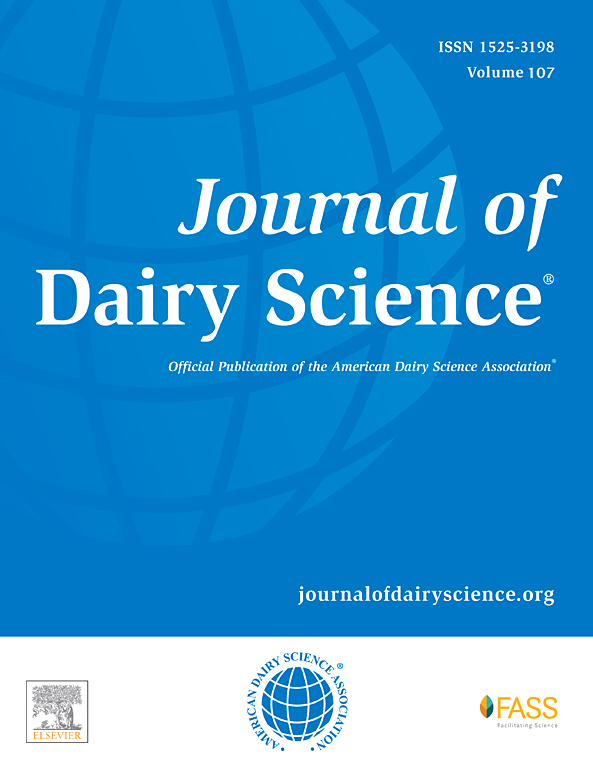On the relationship among linear type traits and functional longevity in the Italian Mediterranean buffalo using a Weibull proportional hazards model
IF 4.4
1区 农林科学
Q1 AGRICULTURE, DAIRY & ANIMAL SCIENCE
引用次数: 0
Abstract
The Weibull proportional hazards model was used to identify the nongenetic effects that affect length of productive life (LPL) of the Italian Mediterranean buffalo. Data were provided by the Italian National Association of Buffalo Breeders and included records of reproductive, productive, and linear type traits from 59,943 buffalo with first calving from 2002 to 2019. Data were divided into 4 geographical regions to determine whether the relationship between the investigated effects and LPL varied by region. Length of productive life was defined as the number of days from the first calving to culling for those buffaloes that were culled (uncensored) or to the date of the last test-day for those that are still alive (censored). The Weibull model included time-dependent effects of herd-year-season of calving, parity and stage of lactation, production as within-herd deviations, as well as time-independent effects of age at first calving, year of birth, type of reproduction (natural mating vs. AI), classifier, and ten linear type traits. The average duration of productive life was 1,604 days. Both year of birth and production level had a significant effect on culling risk. Moreover, culling risk decreased linearly across parities. The reference point for age at first calving relative to other classes was set at 35 months. A significant relationship between linear type traits and relative culling risk was also observed, being highest for buffaloes with the lowest linear scores. The results show that the Weibull model provides consistent and robust risk estimates. Therefore, this model would be recommended for future implementation of the first genetic evaluation of LPL in the Italian Mediterranean buffalo.
使用魏布勒比例危害模型研究意大利地中海水牛的线型性状与功能性长寿之间的关系
利用Weibull比例危害模型确定影响意大利地中海水牛(IMB)生产寿命(LPL)的非遗传效应。数据由意大利国家水牛饲养者协会(ANASB)提供,包括从 2002 年到 2019 年首次产犊的 59943 头水牛的繁殖、生产和线型性状记录。数据被分为 4 个地理区域,以确定所研究的效应与 LPL 之间的关系是否因区域而异。LPL被定义为被淘汰(未删减)的水牛从首次产犊到淘汰的天数,或仍存活(已删减)的水牛从首次产犊到最后测试日的天数。Weibull 模型包括与时间相关的牛群产犊年份-季节、奇数和泌乳阶段、生产量(作为牛群内偏差),以及与时间无关的初产年龄、出生年份、繁殖类型(自然交配与人工授精)、分类器和 10 个线性类型特征。生产寿命平均为 1,604 天。出生年份和生产水平对淘汰风险都有显著影响。此外,阉割风险在不同年龄段呈线性下降。与其他等级相比,初产年龄的参考点定为 35 个月。还观察到线性类型特征与相对淘汰风险之间存在明显关系,线性得分最低的水牛淘汰风险最高。结果表明,Weibull 模型提供了一致且稳健的风险估计值。因此,建议将来对意大利地中海水牛的 LPL 进行首次遗传评估时使用该模型。
本文章由计算机程序翻译,如有差异,请以英文原文为准。
求助全文
约1分钟内获得全文
求助全文
来源期刊

Journal of Dairy Science
农林科学-奶制品与动物科学
CiteScore
7.90
自引率
17.10%
发文量
784
审稿时长
4.2 months
期刊介绍:
The official journal of the American Dairy Science Association®, Journal of Dairy Science® (JDS) is the leading peer-reviewed general dairy research journal in the world. JDS readers represent education, industry, and government agencies in more than 70 countries with interests in biochemistry, breeding, economics, engineering, environment, food science, genetics, microbiology, nutrition, pathology, physiology, processing, public health, quality assurance, and sanitation.
 求助内容:
求助内容: 应助结果提醒方式:
应助结果提醒方式:


